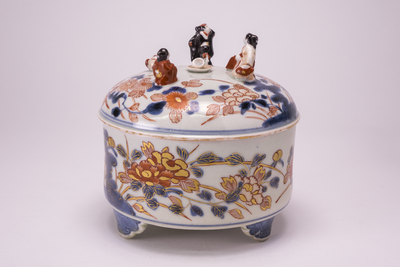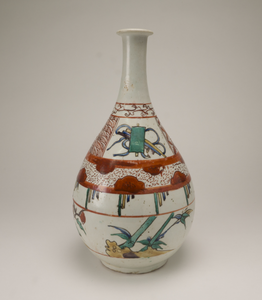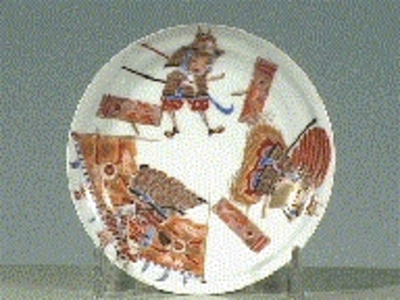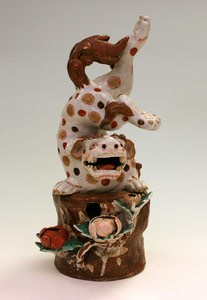281 voorwerpen
sorteren op:
1000 Collectie Beeldende Kunst

JMD-P-2695 Kom,
Periode:
18e eeuw
Deelcollectie:
Japans porselein
Object:
Kom
Beschrijving:
Cilindrische Imari boterpot op drie ruyi-vormige poten met rond deksel. Op het deksel in plastiek drie personen, een staande man, twee knielende vrouwen en vier voorwerpen mogelijk als scène uit een theeceremonie. Gedecoreerd met o.a. pioenrozen en chrysanten in blauw, ijzerrood en goud (Europese invloeden).
Tekst engels:
Cylindrical Imari butter pot on three ruyi-shaped legs with round lid. On the lid in plastic three persons, a standing man, two kneeling women and four objects possibly as a scene from a tea ceremony. Decorated with a.o. peonies and chrysanthemums in blue, iron red and gold (European influences).
Datering:
1700-1799
Techniek:
keramiek
Diameter:
141
Hoogte:
138
Standring:
118
Materiaal:
Porselein
laatste wijziging 25-04-2024
1 gedigitaliseerd
1000 Collectie Beeldende Kunst

JMD-P-2933 Fles,
Periode:
17e eeuw
Deelcollectie:
Japans porselein
Object:
Fles
Beschrijving:
Peer-vormige Kutani fles op voetring, lange nek, platte spreidende mondrand. Versierd in vroege emailkleuren in vijf horizontale secties. Van onder naar boven: een brede band met vier groepen bamboe, orchis, magnolia en rotsen; een band met elf groepen verticale, steeds kleiner wordende lijnen; een band met stippels en halve bloesems; een brede band op de schouder met gelukssymbolen, onderbroken door smalle vakken met geometrische motieven; en een smalle band om de nek met een gestileerde rank.
Flessen met dit type emailkleuren, de 'vroege emailgroep' genoemd, horen tot het eerste polychrome exportgoed dat in Arita vervaardigd werd. Ze tonen een grote verscheidenheid aan motieven en voorstellingen die in de vakkenindeling en de landschappelijke elementen nog aan Chinese voorbeelden doen denken, maar verder een heel eigen Japanse compositie en stijl vertonen. In Nederlandse collecties zijn ze zeldzaam, aangezien ze in eerste instantie vervaardigd werden voor de zuid-oost Aziatische markten. De vorm kan vergeleken worden met flessen versierd in onderglazuur blauw (cat. XX{}). Dit is een bijzonder fraai stuk, met een krachtig geschilderde, opvallende versiering. Flessen met een vergelijkbare decoratie schijnen onbekend te zijn.
Flessen met dit type emailkleuren, de 'vroege emailgroep' genoemd, horen tot het eerste polychrome exportgoed dat in Arita vervaardigd werd. Ze tonen een grote verscheidenheid aan motieven en voorstellingen die in de vakkenindeling en de landschappelijke elementen nog aan Chinese voorbeelden doen denken, maar verder een heel eigen Japanse compositie en stijl vertonen. In Nederlandse collecties zijn ze zeldzaam, aangezien ze in eerste instantie vervaardigd werden voor de zuid-oost Aziatische markten. De vorm kan vergeleken worden met flessen versierd in onderglazuur blauw (cat. XX{}). Dit is een bijzonder fraai stuk, met een krachtig geschilderde, opvallende versiering. Flessen met een vergelijkbare decoratie schijnen onbekend te zijn.
Tekst engels:
Pear-shaped bottle on footring, long neck, flat spreading mouthrim. Decorated in early enamel colours in five horizontal sections. From top to bottom: a wide band with four groups of bamboo, orchis, magnolia and rocks; a band with eleven groups of vertical, gradually diminishing lines; a band with dots and half-flowers; a wide band on the shoulder with auspicious symbols separated by narrow panels with geometric motifs; and a narrow band with a stylised scroll around the neck.
Bottles with these enamel colours, called the 'early enamel group', form part of the first polychrome export goods manufactured in Arita. They are decorated with a wide variety of motifs and representations and the way in which they are divided into panels as well as the landscape elements are redolent of Chinese examples. Otherwise they show a wholly Japanese composition and style. They are rare in Dutch collections having been primarily manufactured for the south-east Asian markets. The shape is comparable to that of bottles decorated in underglaze blue (cat. XX{}). This is a particularly fine piece, with a powerfully painted, striking decoration. No other bottles with a similar decoration appear to be recorded.
Bottles with these enamel colours, called the 'early enamel group', form part of the first polychrome export goods manufactured in Arita. They are decorated with a wide variety of motifs and representations and the way in which they are divided into panels as well as the landscape elements are redolent of Chinese examples. Otherwise they show a wholly Japanese composition and style. They are rare in Dutch collections having been primarily manufactured for the south-east Asian markets. The shape is comparable to that of bottles decorated in underglaze blue (cat. XX{}). This is a particularly fine piece, with a powerfully painted, striking decoration. No other bottles with a similar decoration appear to be recorded.
Datering:
1660-1670
Techniek:
keramiek
Diameter:
174
Hoogte:
321
Standring:
100
Materiaal:
Porselein
laatste wijziging 25-04-2024
1 gedigitaliseerd
1000 Collectie Beeldende Kunst

JMD-P-3086 Schotel,
Periode:
19e eeuw
Deelcollectie:
Japans porselein
Object:
Schotel
Beschrijving:
Wit Satsuma eierschaal schoteltje met op het plat drie krijgers in meerdere kleuren.
Signatuur:
Hall mark op de onderzijde.
Datering:
1880-1920
Techniek:
keramiek
Diameter:
124
Hoogte:
23
Standring:
63
Materiaal:
Porselein
laatste wijziging 25-04-2024
1 gedigitaliseerd
1000 Collectie Beeldende Kunst

JMD-P-3102 Beeld,
Periode:
18e eeuw
Deelcollectie:
Japans porselein
Object:
Beeld
Beschrijving:
Beeld van een Shishi (wachtersleeuw) op een rots. Beschilderd in ijzerrood, bruin, zwart, groen en goud. Het dier is in actie weergegeven, alsof het er na een sprong zojuist op terecht is gekomen, het lijf in een bocht, zijn rechter achterpoot nog omhoog, de linker achterpoot gebogen, de bek open, tanden en tong zichtbaar. De rots is hol en aan de onderkant open, begroeid met pioenen in knop.
De Shishi heeft een woest uiterlijk, grote ogen, krullende manen en staart. Het is een mythologisch dier, ontleend aan de Chinese iconografie en wordt in het Westen Boeddhistische Hond, Fo-Hond of Leeuw-Hond genoemd wordt. In Japan heeft de Shishi, net als in China, een beschermende funktie en weert onheil af. In het Westen waren dergelijke figuren geliefd als exotische elementen in het interieur.
De Shishi heeft een woest uiterlijk, grote ogen, krullende manen en staart. Het is een mythologisch dier, ontleend aan de Chinese iconografie en wordt in het Westen Boeddhistische Hond, Fo-Hond of Leeuw-Hond genoemd wordt. In Japan heeft de Shishi, net als in China, een beschermende funktie en weert onheil af. In het Westen waren dergelijke figuren geliefd als exotische elementen in het interieur.
Tekst engels:
Figure of a shishi (lion) on a rock. Decorated in iron-red, brown, black, green and gold. The animal is shown in action, as if landing after jumping. Its body is bent, the right hind leg is still raised, the left is bent and the mouth is open showing teeth and tongue. The rock, overgrown with budding peonies, is hollow and open on the base.
The Japanese shishi has a fierce expression, bulging eyes, a curly mane and a tail. It is a mythical animal derived from Chinese iconography and is called Buddhist Dog, Fo-dog or Lion-dog in the West. As in China, the shishi, is a guardian and protects from calamity and evil (see cat. XX{}). Such figures were popular elements in Western interior decoration. No comparable examples appear to have been published.
The Japanese shishi has a fierce expression, bulging eyes, a curly mane and a tail. It is a mythical animal derived from Chinese iconography and is called Buddhist Dog, Fo-dog or Lion-dog in the West. As in China, the shishi, is a guardian and protects from calamity and evil (see cat. XX{}). Such figures were popular elements in Western interior decoration. No comparable examples appear to have been published.
Datering:
1700-1730
Techniek:
afgietsel
Diameter:
205
Hoogte:
430
Standring:
165
Materiaal:
Porselein
laatste wijziging 25-04-2024
1 gedigitaliseerd

 Mijn Studiezaal (inloggen)
Mijn Studiezaal (inloggen)


